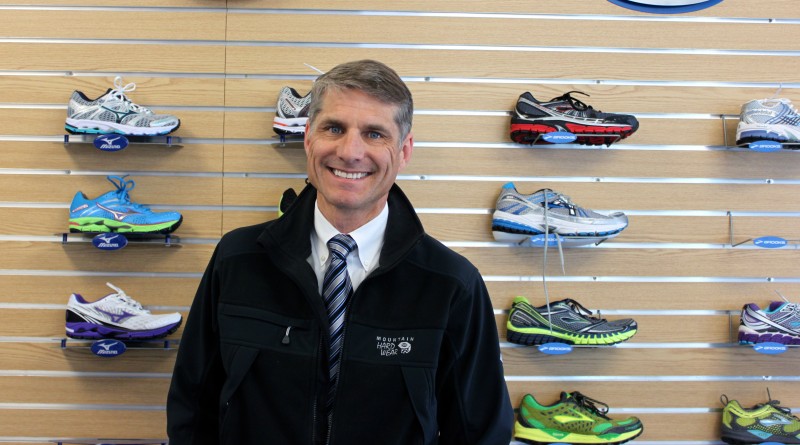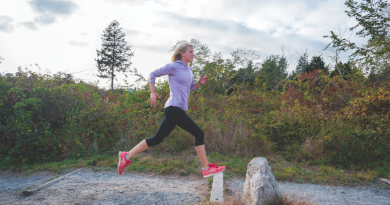The Basics of Good Running With Coach Sam Davis
Burlington — If you want running advice, it’s best to ask a runner and Sam Davis has a wealth of knowledge and experience. A native Vermonter and competitive runner for over 30 years, Davis has run them all – from leisurely 5k runs to challenging half and full marathons at a blistering pace. Davis started in high school as a track athlete and attended the University of Vermont, where he was a cross country champion and record holder at both 5,000 meters (outdoor) and the distance medley relay. He’s also an inductee of the RunVermont hall of fame.
Today, he is still running and is also an expert trainer, certified as a USA Track & Field Level 2 Endurance Coach, and an instructor for Marathon 201 and Half Marathon 101 classes at RunVermont since 2005. As a highly qualified coach, he works with every variety of runner from a person hoping to finish their first 5 k race to elite level athletes, intending to shave seconds off their personal records.
The Internet is full material both good and bad, Davis says, and it can be difficult to tell what’s helpful and what’s not, or worse, harmful. Davis says training regimens are like chili recipes – everybody’s got one and they all think they’ve got the best.
“You need certain things, or else you can’t call it chili,” Davis says. “The same thing goes for running. There are a bunch of things you could add, but you need some basics in order to call it a viable program.”
So when it comes to finding a training regimen that works for you, it’s important to keep an eye on the basics. Like a recipe requires specific ingredients, so does a training regimen.
Here are some of the basics:
Tip 1: Set goals
When Davis first meets with a client, he does a preliminary interview, during which he learns about their running experience, any past injuries and their motivations for seeking a professional coach. During these preliminary sessions, he also likes to get an idea of the person’s immediate and long-term goals.
If you’re training for your first marathon or running to lose weight, it helps to have a goal to work towards and take manageable steps towards it.
“What I like to do is give them something that is fairly achievable even if they haven’t run but are in fairly good shape and then get feedback from them,” he says.
In addition, Davis says it’s important to have an idea of the big picture – what you’re plans for running are after you finish that first race.
“I try and set them towards the long-term,” he says. “While they have that goal race, I try and make sure they’re looking past it and getting perspective on what they’re doing.”
Tip 2: Get the right shoes
While every pair of new running shoes feels comfortable right out of the box, an often-overlooked area is the importance of running shoes that match the stride and running patterns of the wearer.
“Nobody’s perfect,” says Davis, referring to the variety of strides and gaits people have. “Everyone has idiosyncratic issues with their running and it’s important to see if those become a problem. Normally they would in the wrong shoe.”
A good pair of running shoes accounts for the shape the foot takes on contact. The goal of the shoe is to allow your foot to move the way nature intended, without any extra material or restriction.
Tip 3: Go the distance
For newer runners, the distance they intend to run can be difficult to conceptualize. What does five, ten or 15 kilometers feel like to the runner? When you know the distance you want to do, resist any temptation to set time goals too early and focus instead on completing the distance. When you know how the distance feels, then you can begin to develop a more refined goal. Davis says the experience of completing the distance you intend to race before you step up to the starting line will help boost your confidence.
“Once you get that, the mystery is gone,” says Davis. “When you accomplish each distance then you’ll know what goes into it. Even when the first-time marathoner crosses the finish line they know how hard it is and I would wager that their next race, if they did nothing different, could be faster simply because they now know what it takes.”
Tip 4: Food and Drink
The food you consume becomes the fuel that your body will use. Davis says for shorter races, you won’t need to modify your diet much, as most people consume enough carbohydrates every day. The pasta dinners customary before the start of races are good for the sake of tradition, but where lots of carbohydrates become more vital is in longer distances such as marathons.
“If you’re choosing a healthy lifestyle with enough physical activity, then your diet should be commensurate with that, “ he says. While Davis isn’t a dietician, he says the night before a five-kilometer race runners should focus more on getting a good night’s rest instead of a big plate of pasta.
As for water, Davis says most people don’t drink enough, even though they think they might. He drinks three to four liters of water every day in the summer and the winter.
“The impact of being under-hydrated is significant,” he says. “And I think that’s largely overlooked by a lot of experienced runners as well as novice runners.”
Tip 5: Rest
After any kind of an intense exercise – be it sprints or a long distance run – the body needs time to rest. When the body has time to adapt to the stress of the workouts, that’s when it becomes stronger. It’s also possible to rest actively. A light jog or a relaxed bike ride can be good as long as your activity of choice doesn’t provide the same amount of stress as your tougher workouts.
Tip 6: Run with a purpose
“Every day of your running has to have a purpose,” Davis says. “That can be as simple as having a recovery day from a hard work out or a race.” When you start, avoid “junk miles,” or miles run simply for the point of running. In order to maximize whatever plan you’re following, your recovery days will be just as important as your tougher ones, so be aware of your running schedule and your reasons for keeping it.
As you continue, you’ll build up your “running IQ” and your ability to determine what you need to get better.
Keep in mind that what works for one person isn’t going to work for everyone. Working out with a group of people may get you out the house and in good shape, but it may not give you the competitive edge you need.
Tip 7: Change it up
As you improve, Davis says it’s important to continue to build on your exercises; as you grow stronger, what previously was a challenge may not be as much anymore.
“Improvements are seen far more commonly in less experienced runners,” Davis says. “When you’re highly trained or have been running quite a bit trying to find an edge or get faster, it becomes more difficult because your body’s well trained at that point.”
Keeping yourself from hitting that plateau involves more than adding progressively more miles; it’s about finding new routines and workouts through trial and error. Don’t be afraid to pick up any one of the many books on running or talk to a more experienced runner, who might be able to give you anecdotal advice. Whatever your preferred method, the crucial element is finding a pattern that meets your needs.
“What works for one person is not going to work for the next one,” Davis says. “In my mind, it’s not one size fits all. There are general things that people should be doing, but in terms of training someone might need more speed where someone else need more mileage. It’s all different.”



